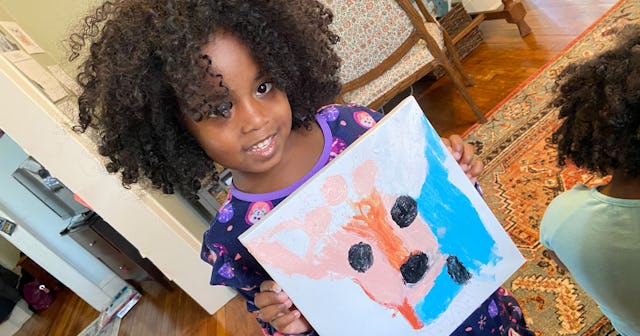My Daughter Has Created Her Own 'Art Therapy' And It Works Wonders For Her

She takes crayons and scissors in our minivan, even for the shortest of distances. She carries around a red little art caboodle which houses her paper, colored pencils, markers, and anything else she can fit into there just in case she’s feeling inspired in the middle of Target. She is one of the most resourceful kids I’ve met. My daughter even uses our recyclables to make things;, recently she chose to repurposed our family-sized Cheez-It box and make it her “friend” who she named Marsha. This friend also went in the car with us, seatbelt and all, right between her and her twin sister’s booster seat.
My kid likes art, and at just six years old, she can self-regulate, she can remove herself from situations that cause her stress or anxiety, and simply say, “I need some alone time,” and she will leave the situation. When I go to look for her, she is off, making art and in her zone. Art is my kid’s way of not only expressing herself, but helping to quiet her big emotions — from fear to anxiety to excitement and boredom.
Courtesy of Nikkya Hargrove
Often, kids who experience trauma can benefit from some form of therapy, no matter their ages. For children who were displaced during Hurricane Katrina back in 2005, art therapy became their solace, their way to cope. Over the last year, our kids have dealt with the stressors of a worldwide pandemic that many of us are still trying to figure out how to cope with. Art can help.
In an article called Does Art Therapy Help You Manage Anxiety Symptoms, President of the American Art Therapy Association, Margaret Carlock Russo, Ed.D, LCAT(NY), ATR-BC, ATCS, states, “Different studies and research [show] that when we engage in art-making, it helps the neurological system relax. Brain chemical levels will decrease and bring about relaxation for many people, which also helps the nervous system calm down.” And she is completely right.
Courtesy of Nikkya Hargrove
The moment my daughter finishes a piece, takes a step back and looks at it, there is a calm in the air, a way of being for her that differs from how she began her piece. She gets into her zone and soars. Her body language and words even transform. Her posture softens and her body calms down, engaging in movements that are less reactive and more intentional. When she stands in front of her drawing, marker in hand, her breaths are quiet and peaceful. Making art gives the artist, no matter how “good” the drawing or artwork, the ability to be present in that moment of creation.
In adults, when we engage in art therapy, symptoms of anxiety or panic disorders can be relieved, and it’s the same for kids. Art therapy can increase quality of life, decrease symptoms of anxiety, help emotional regulation and provide a strategy for them to cope. Carlock Russo goes on to say, “We get people to stop and focus on one thing. People can also do this with deep breathing and other strategies, but art-making can be an easy, accessible way to do this, too. Art expression also provides sensory input in other ways because you are touching materials, and it also [initiates] the release of stress from the playfulness of it all.”
Courtesy of Nikkya Hargrove
As the crayons, colored pencils, and random marker stains we find in our minivan pile up, they also bring me some peace of mind. I know that my daugher is working “it” — whatever it is — out through her art. Art has become her jam, her activity of choice, and she is really good at it. Even the La Croix box Wonder Woman shields brought a huge smile to her face, calm to her heart, and gave her the confidence to say, “Aren’t these so cool, Mommy?” and my answer was all she needed to turn my home office into her very own art studio.
Her love for art and for a zen kind of being, has come with my needing to be more flexible, less Type-A about how clean my house is (or isn’t). I find glitter and glue stuck to my work papers. I find mounds of used copy papers strewn throughout our house with a few failed attempts at creating her masterpiece of the moment. But creating makes her happy and more in touch with her feelings. She is self-regulating through her own kind of art therapy, and for that, she can use up all 500 sheets.
This article was originally published on